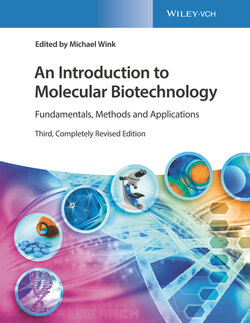Читать книгу An Introduction to Molecular Biotechnology - Группа авторов - Страница 40
4.1.2 Composition and Function of Chromosomes
ОглавлениеWith eukaryotes, the DNA in chromosomes is present as a linear double helix. In humans there are 22 paired autosomes (a copy from both the father and mother) and two sex chromosomes (XY in males and XX in females), giving a total of 46 chromosomes in the cell nucleus (Figure 4.3). The arrangement of genes and gene clusters on specific chromosomes is often highly conserved in vertebrates. These clusters are termed regions of synteny. In some cases, genes causing specific diseases have already been assigned to specific chromosomes. A selection is presented in Figure 4.3. Through specific hybridization procedures (e.g. fluorescence in situ hybridization[FISH]), it is possible to locate genes on individual chromosomes and make them visible. Such location is an important assignment in human genetics and the diverse genome projects. Also the genome projects often allow an allocation of a gene to a particular chromosome.
Figure 4.3 Schematic illustration of human chromosomes. The indentations indicate centromeres. Staining the chromosomes results in a typical band pattern. A number of genes involved in diseases have already been located.
Chromosomes consist of a centromere, to which the microtubules attach during cell division, diverse replication starting points (origins of replication), and telomere sequences on the ends (Figure 4.4). These telomeres are made up of over 1000 short repetitive sequence elements (e.g. GGGTTA in humans) and are then attached by a telomerase to the chromosomes (Figure 4.5). The telomeres prevent the exonucleases from cleaving the chromosomes from the ends. Telomerase is only active in embryonic cells and synthesizes long telomere residues on the ends of the chromosomes. The expression of telomerase is later inactivated (except in tumor cells, in which it is usually permanently activated and in stem cells), so that the telomeres cannot be lengthened further during later replication cycles. After 70–80 cell divisions, cell division usually succumbs to the fact that the exonucleases have been able to nibble away the telomere and have disrupted an important part of functional genes (replicative cell senescence). It is speculated that the aging process and death are controlled by this internal clock.
Figure 4.4 Important structural elements of chromosomes necessary for the replication and separation of chromatids. The centromere region consists of repetitive α‐satellite DNA, which is rich in A–T base pairs. It is flanked by centric heterochromatin. Kinetochore proteins that form an inner and an outer kinetochore plate bind to the area of α‐satellite DNA. The kinetochore proteins bind the microtubules of the spindle apparatus, which pulls the chromatid halves apart.
Figure 4.5 Principle of telomere replication. The telomerase exhibits an RNA template, through which it binds a TA residue of DNA. The telomerase lengthens the DNA strands complementary to the RNA template. When a repeat region is synthesized, the telomerase jumps to the next TA residue and begins the synthesis. This can be repeated over 1000 times. The opposite strand will be synthesized by DNA polymerase, which through the help of its own primase uses a complementary RNA primer on the 5′‐end and links this to the next nucleotide.
DNA is not present in the chromosomes as free strands, but histone proteins of a basic nature are wrapped around them. DNA is wound around four histone proteins (H2A, H2B, H3, and H4), which exhibit many positively charged lysine residues and form octameric cylinders (Figure 4.6). This is how nucleosomes, which each contain about 145 bp of DNA, are constructed. Here, ionic bonds between the positively charged lysine residue and the negatively charged phosphate groups of the DNA play an important role. A linear DNA section of about 80 bp of DNA, which binds sequence‐specific proteins, is usually present between the two neighboring nucleosomes.
Figure 4.6 From the nucleosome to the condensed metaphase chromosome. The DNA winds itself around the octamer histone protein complex forming nucleosomes. The nucleosomes are organized into 30‐nm‐thick chromatin fibrils that in interphase are arranged together forming 300‐nm‐thick bundles. In metaphase chromosomes the chromatin is densely packed through repeated bundling.
When a gene is transcribed, the tight complex between DNA and histones must be loosened. This is achieved by diverse protein modifications, such as acetylation, methylation, phosphorylation, and adenosine triphosphate (ATP)‐dependent chromatin remodeling complexes (together with histone H1).
Chromosomes are present in their more extended form in the interphase of the cell cycle. Only in metaphase do we see the well‐known metaphase chromosomes, in which the DNA is highly condensed (1000 times shorter than in the extended form; Figure 4.6).
